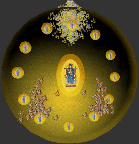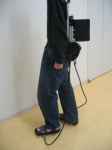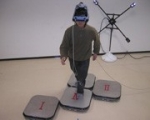Aug 17, 2006
Using VR for Teaching Social Understanding to Autistic Adolescents
Using Virtual Environments for Teaching Social Understanding to 6 Adolescents with Autistic Spectrum Disorders.
J Autism Dev Disord. 2006 Aug 10;
Authors: Mitchell P, Parsons S, Leonard A
Six teenagers with Autistic Spectrum Disorders (ASDs) experienced a Virtual Environment (VE) of a café. They also watched three sets of videos of real cafés and buses and judged where they would sit and explained why. Half of the participants received their VE experience between the first and second sets of videos, and half experienced it between the second and third. Ten naïve raters independently coded participants' judgments and reasoning. In direct relation to the timing of VE use, there were several instances of significant improvement in judgments and explanations about where to sit, both in a video of a café and a bus. The results demonstrate the potential of Virtual Reality for teaching social skills.
12:30 Posted in Virtual worlds | Permalink | Comments (0) | Tags: virtual reality, cybertherapy
Virtual Reality Exposure Therapy: 150-Degree Screen to Desktop PC
Virtual Reality Exposure Therapy: 150-Degree Screen to Desktop PC.
Cyberpsychol Behav. 2006 Aug;9(4):480-9
Authors: Tichon J, Banks J
Virtual reality exposure therapy (VRET) developed using immersive or semi-immersive virtual environments present a usability problem for practitioners. To meet practitioner requirements for lower cost and portability VRET programs must often be ported onto desktop environments such as the personal computer (PC). However, success of VRET has been shown to be linked to presence, and the environment's ability to evoke the same reactions and emotions as a real experience. It is generally accepted that high-end virtual environments (VEs) are more immersive than desktop PCs, but level of immersion does not always predict level of presence. This paper reports on the impact on presence of porting a therapeutic VR application for Schizophrenia from the initial research environment of a semi-immersive curved screen to PC. Presence in these two environments is measured both introspectively and across a number of causal factors thought to underlie the experience of presence. Results show that the VR exposure program successfully made users feel they were "present" in both platforms. While the desktop PC achieved higher scores on presence across causal factors participants reported they felt more present in the curved screen environment. While comparison of the two groups was statistically significant for the PQ but not for the IPQ, subjective reports of experiences in the environments should be considered in future research as the success of VRET relies heavily on the emotional response of patients to the therapeutic program.
12:28 Posted in Virtual worlds | Permalink | Comments (0) | Tags: virtual reality, cybertherapy
Aug 08, 2006
The Travels of Mariko Horo
Re-blogged from Networked Performance
The Travels of Mariko Horo by Tamiko Thiel: Sometime between the 12th and the 22nd centuries Mariko HMrM, Mariko the Wanderer, journeys westward from Japan in search of the Buddhist Paradise floating in the Western Seas. She does find Paradise, but finds also a chilling, darker side to the West, an island where lost souls are held in an eternal Limbo. She encapsulates her impressions of the places she visits in a series of 3D virtual worlds and invites you to see the West through her eyes.
The Travels of Mariko is an interactive 3D virtual reality installation. The image is generated in real time on a fast gaming PC and projected on a large 9 x 12 screen to produce an immersive experience. Users move their viewpoint through the virtual environment with a joystick or similar navigational input device. Mariko is a fictitious character Thiel invented to incorporate the viewpoint for the project - users will never actually see Mariko, except perhaps in a mirror. In essence they will be Mariko, seeing the exotic and mysterious Occident through her eyes and experiences.
The virtual environment is sensitive to their presence, changing around them as a result of their movements and actions: An empty church fills with saints who vanish into the heavens. A basilica transports the user directly into the Western Cosmos, where angels sing the praises of the Goddess of Compassion. A pavilion takes users deep into the underwater realm of the Heavenly King. A plain wooden chapel leads into a Limbo of constant torment.
Music for Mariko Horo is embedded in the piece itself, localized to specific places within the 3D world. The composer Ping Jin, Professor of Music at SUNY/New Paltz, studied music both in his native China and in the USA. Ping describes the music as "creating a sonic dimension for Mariko's meditation on the mythic West. Created from both sampled and computer generated sounds, there are fusions and juxtapositions of Eastern and Western sounds to enhance the scene and mood of each section."
World premiere:
July 29 - November 26, 2006: "Edge Conditions" show, part of the Pacific Rim Theme of ISEA2006 Symposium/ZeroOne San Jose Festival at the San Jose Museum of Art, USA.
14:13 Posted in Cyberart, Virtual worlds | Permalink | Comments (0) | Tags: cyberart, virtual reality
Aug 04, 2006
Using Simulation and Virtual Reality Technology to Assess Continuing Nurse Competency
Education and Practice Collaboration: Using Simulation and Virtual Reality Technology to Assess Continuing Nurse Competency in the Long-Term Acute Care Setting.
J Nurses Staff Dev. 2006 July/August;22(4):163-169
Authors: Landry M, Oberleitner MG, Landry H, Borazjani JG
Assessment of continuing competence of staff is a challenge for many healthcare organizations. There is no clear consensus as to what constitutes continuing competence or how to measure that competence. Methods for assessing continued competence of nurses are varied. A novel method, simulation and virtual reality technology, was used to assess the competency of nurses employed in long-term acute care hospitals in Louisiana. This article will describe the project which was the result of a collaborative effort between a large healthcare organization and a school of nursing.
17:35 Posted in Virtual worlds | Permalink | Comments (0) | Tags: virtual reality
Aug 03, 2006
Virtual bots teach each other
From New Scientist Tech
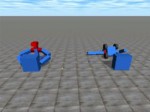
"Robots that teach one another new words through interaction with their surroundings have been demonstrated by UK researchers. The robots, created by Angelo Cangelosi and colleagues at Plymouth University, UK, currently exist only as computer simulations. But the researchers say their novel method of communication could someday help real-life robots cooperate when faced with a new challenge. They could also help linguists understand how human languages develop, they say..."
Continue to read the full article on New Scientist
Watch the video
21:11 Posted in AI & robotics, Virtual worlds | Permalink | Comments (0) | Tags: artificial intelligence
Aug 02, 2006
3D blog
Thanks to Giuseppe Riva (reporting from Siggraph 2006)
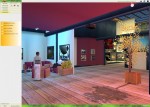
12:50 Posted in Future interfaces, Telepresence & virtual presence, Virtual worlds | Permalink | Comments (0)
Photos transformed into 3D model
With Photosynth you can:
- Walk or fly through a scene to see photos from any angle.
- Seamlessly zoom in or out of a photograph whether it’s megapixels or gigapixels in size.
- See where pictures were taken in relation to one another.
- Find similar photos to the one you’re currently viewing.
- Explore a custom tour.
- Send a collection to a friend.
11:55 Posted in Virtual worlds | Permalink | Comments (0)
ECGBL 2007: The European Conference on Games Based Learning
University of Paisley, Scotland, UK 25-26 October 2007
Over the last ten years, the way in which education and training is delivered has changed considerably with the advent of new technologies. One such new technology that holds considerable promise for helping to engage learners is Games-Based Learning (GBL).
The Conference offers an opportunity for scholars and practitioners interested in the issues related to GBL to share their thinking and research findings. The conference examines the question “Can Games-Based Learning Enhance Learning?” and seeks high-quality papers that address this question. Papers can cover various issues and aspects of GBL in education and training: technology and implementation issues associated with the development of GBL; use of mobile and MMOGs for learning; pedagogical issues associated with GBL; social and ethical issues in GBL; GBL best cases and practices, and other related aspects. We are particularly interested in empirical research that addresses whether GBL enhances learning. This Conference provides a forum for discussion, collaboration and intellectual exchange for all those interested in any of these fields of research or practice.
Important dates:
Abstract submission deadline: 17 May 2007
Notification of abstract acceptance: 24 May 2007
Full paper due for review: 5 July 2007
Notification of paper acceptance: 16 August 2007
Final paper due (with any changes): 6 September 2007
A full call for papers, online submission and registration forms and all other details are available on the conference website.
10:15 Posted in Creativity and computers, Positive Technology events, Virtual worlds | Permalink | Comments (0) | Tags: serious gaming
Jul 31, 2006
Immersive Medical Telepresence conference
Phoenix, Arizona, 6-7 September 2006
From the conference website
The Health Sciences, perhaps more than any other discipline, is dependent of images / video and the analysis of these images to be successful. This is true in biomedical research, health education and of course in clinical care. These images are increasingly digital and improving in resolution by orders of magnitude. This simultaneously allows more flexibility with the analysis of the image and much better analysis. The data resources are logically growing exponentially there is a growing need to share and compare images.
The ability to effectively use and share these resources is often a local issue with individual solutions being developed. There are exceptions and when they are discovered they are often treated as significant success stories. For example, the SUMMIT Project at Stanford University has created a significant set of stereoscopic and haptically enabled Digital Anatomy resources. These resources and the expertise at Stanford will be used across the nation and now internationally to teach anatomy courses.
As the health sciences continue to become more specialized and the educational resources become more difficult to locate, advanced networking that allows secure, reliable access to expertise and high quality resources is critical. The ability to create virtual organizations and collaborate with and among students, professors, researchers, and clinicians irrespective of location is of increasing value.
At the same time, large-capacity research networks (e.g., Internet2 and peered networks, GLORIAD) and high-quality video applications (e.g., DV-over-IP, developed by the WIDE Project and stereoscopic HD video-over-IP realized by GIST are making such virtual collaboration technically possible and financially affordable. However, the absence of (human) networking opportunities has hampered the development of sustainable testbeds and slowed the rate of innovation.
This workshop will focus on our ability to effectively use and manipulate image / video resources irrespective of their location. It will also showcase many emerging technologies relevant to the medical field. Most importantly, it will provide an opportunity for those in the medical community to learn alongside experts in the area of video technologies and large capacity networking about the challenges ahead and to begin a discussion about how those challenges can be met.
23:26 Posted in Positive Technology events, Telepresence & virtual presence, Virtual worlds | Permalink | Comments (0) | Tags: virtual reality, telepresence
Applications of Virtual Reality Technology in the Measurement of Spatial Memory in Patients with Mood Disorders
The January 2006 CNS Spectrums included an article about virtual reality (VR) technology as a treatment option in psychiatry and Dr. Gorman welcomed letters discussing novel applications of VR in psychiatry. Much of the published work in this area is treatment-related. It appears that a limited number of researchers have considered using this technology for clinical assessment and research purposes. This is likely to change as immersive VR shows promise for increasing ecological validity in assessment and providing a much richer set of behavioural data.
In collaboration with the Informatics Research Institute (IRI) at Newcastle University in Newcastle upon Tyne, England, we are assessing the validity of this approach. The IRI manages an immersive VR suite, and our collaboration has allowed us to develop a novel paradigm to test spatial memory in patients with mood disorders. Our interest in spatial memory in this group stems from neuroimaging research reporting atrophy in the hippocampal region for patients with major depressive disorder and bipolar disorder. The hippocampus is involved in spatial memory, and individuals with hippocampal lesions are impaired on tasks of spatial memory.
17:30 Posted in Cybertherapy, Virtual worlds | Permalink | Comments (0) | Tags: virtual reality, cybertherapy
Jul 27, 2006
Virtual Reality therapy for Iraq veterans

A therapist at the Naval Medical Center in San Diego, Calif., Wood monitors patients' heart and breathing rates and even how much they're sweating to see the effect of the virtual environments. The aim is to get patients to draw on their meditation training to regain perspective—and stay calm—when a stimulus causes an emotional response. "The idea being to be in the high-stimulus environment for a long period of time, maintaining low psycho-physiological arousal," Wood says. "The person then can take that learning in the therapeutic environment and transport it out or generalize it to day-to-day life."There may be a great need for PTSD therapy among veterans of the war in Iraq. A 2004 study published in the New England Journal of Medicine estimates that PTSD afflicts about 18% of the troops in Iraq. That study took place early in the war, and the figure now may be higher, says Emory psychiatry professor Barbara Rothbaum. She co-owns Virtually Better, a virtual reality treatment company that has received funding from the ONR to develop and test a version of the therapy. "Things over the past few years have gotten even worse," she says. "I hope we're wrong, but I think everybody's expecting probably a higher rate of PTSD." There are currently 127,000 troops stationed in Iraq, according to the U.S. Defense Dept.
The point is not to retraumatize the patients but to allow the individuals to cope with painful experiences. "The concept here is that by doing this in a very modestly paced manner, the person feels little bits of anxiety as they go through this, but not at a level that overwhelms them," says Albert "Skip" Rizzo, a research scientist at the Institute for Creative Technologies. "Eventually they're actually in the Humvee, driving down the road, and children are by the side of the road, and an IED (improvised explosive device) goes off and there's body parts everywhere."
Read the whole article here...
12:25 Posted in Virtual worlds | Permalink | Comments (0) | Tags: cybertherapy
Designing VR Exposure Therapy Simulations for Post-Traumatic Stress Disorders

"Virtual reality (VR) provides a tool that can allow therapists to gradually intensify a simulation of the traumatic events rather than relying on pure talk and storytelling. (..) At Imprint Interactive, we have been involved with a number of PTSD VR exposure therapy research projects (..)
These include a simulation of the tragic events of 9/11/01, a simulation of a terrorist bus bombing for a research group at the University of Haifa in Israel, and two simulations for treating U.S. soldiers returning from Middle East conflict. (..)
This is a familiar goal in both game design and VR. In game design we call the engagement process “fun” (..) . In VR we call the engagement process presence.
The (..) goal is to make the environment sufficiently reminiscent of the patient’s experience that it evokes memories of the traumatic events.
These applications include functionality that allows therapists to dynamically control the intensity of the experience for the patient, increasing or decreasing the level of stimulation and tension according to the level of anxiety.
Design Guidelines
Our job as virtual environment designers is to seek the sweet spot on the suspension of disbelief curve and avoid wasting resources that would only be dumped into the Uncanny Valley. In the case of VR Exposure Therapy applications I would suggest that the metaphor does double-duty and can also inform our selection of appropriate content to achieve reminiscence: we seek the sweet spot on the curve where we have included sufficient contextual details to evoke responses from a wide variety of patients without adding too much specific information that could distract from some patients’ experiences. (..)
- Favor the suggestive over the specific. (..)
- Use intentional ambiguity to cover a range of possible scenarios. (..)
- Use systemic designs and parallel information to specify and disambiguate. (..)
More than one researcher has reported that VR Exposure therapy patients, when recalling their therapy experiences, have occasionally described significant components of their experience in VR that were not actually present in the simulation!"
11:16 Posted in Virtual worlds | Permalink | Comments (0) | Tags: cybertherapy
Jul 25, 2006
The Most Realistic Virtual Reality Room In The World
Via Science Daily
More than $4 million in equipment upgrades will shine 100 million pixels on Iowa State University's six-sided virtual reality room. That's twice the number of pixels lighting up any virtual reality room in the world and 16 times the pixels now projected on Iowa State's C6, a 10-foot by 10-foot virtual reality room that surrounds users with computer-generated 3-D images. That means the C6 will produce virtual reality at the world's highest resolution.
Read the article
22:27 Posted in Virtual worlds | Permalink | Comments (0)
Jul 20, 2006
Using thought power to control artificial limbs
Nature 442, 164-171(13 July 2006)
Leigh R. Hochberg, Mijail D. Serruya, Gerhard M. Friehs, Jon A. Mukand, Maryam Saleh, Abraham H. Caplan, Almut Branner, David Chen, Richard D. Penn and John P. Donoghue
Neuromotor prostheses (NMPs) aim to replace or restore lost motor functions in paralysed humans by routeing movement-related signals from the brain, around damaged parts of the nervous system, to external effectors. To translate preclinical results from intact animals to a clinically useful NMP, movement signals must persist in cortex after spinal cord injury and be engaged by movement intent when sensory inputs and limb movement are long absent. Furthermore, NMPs would require that intention-driven neuronal activity be converted into a control signal that enables useful tasks. Here we show initial results for a tetraplegic human (MN) using a pilot NMP. Neuronal ensemble activity recorded through a 96-microelectrode array implanted in primary motor cortex demonstrated that intended hand motion modulates cortical spiking patterns three years after spinal cord injury. Decoders were created, providing a 'neural cursor' with which MN opened simulated e-mail and operated devices such as a television, even while conversing. Furthermore, MN used neural control to open and close a prosthetic hand, and perform rudimentary actions with a multi-jointed robotic arm. These early results suggest that NMPs based upon intracortical neuronal ensemble spiking activity could provide a valuable new neurotechnology to restore independence for humans with paralysis.
23:59 Posted in Brain-computer interface, Neurotechnology & neuroinformatics, Virtual worlds | Permalink | Comments (0) | Tags: brain-computer interface
New Google3D concept
Re-blogged from Smart Mobs

19:05 Posted in Virtual worlds, Wearable & mobile | Permalink | Comments (0) | Tags: virtual reality
Jul 03, 2006
New device for reproducing smells
Via Cognitive Daily
A team of researchers in Japan has built a device that is capable of reproducing an impressively large array of smells, says a report in New Scientist.
The system will use 15 chemical-sensing microchips, or electronic noses, to pick up a broad range of aromas. These are then used to create a digital recipe from a set of 96 chemicals that can be chosen according to the purpose of each individual gadget. When you want to replay a smell, drops from the relevant vials are mixed, heated and vaporised. In tests so far, the system has successfully recorded and reproduced the smell of orange, lemon, apple, banana and melon. "We can even tell a green apple from a red apple," Team member Pambuk Somboon says.
23:43 Posted in Virtual worlds | Permalink | Comments (0)
Jun 06, 2006
3D Topicscape

3D Topicscape is a info visualization application that allows organizing different types of computer files (i.e. documents, images, websites etc) in a 3D landscape. The mindmaps-like approach helps users to discover hidden details and relationships between data.
from the website:
3D Topicscape is a computer software that works with you to organize and find information held in your computer. And it's a strong and flexible way for you to plan your approach on a new project even before you have collected any files or information, using an approach similar to concept or mind maps, but in 3D.
18:40 Posted in Virtual worlds | Permalink | Comments (0) | Tags: virtual reality
May 18, 2006
Impaired allocentric spatial memory underlying topographical disorientation
Impaired allocentric spatial memory underlying topographical disorientation.
Rev Neurosci. 2006;17(1-2):239-51
Authors: Burgess N, Trinkler I, King J, Kennedy A, Cipolotti L
The cognitive processes supporting spatial navigation are considered in the context of a patient (CF) with possible very early Alzheimer's disease who presents with topographical disorientation. Her verbal memory and her recognition memory for unknown buildings, landmarks and outdoor scenes was intact, although she showed an impairment in face processing. By contrast, her navigational ability, quantitatively assessed within a small virtual reality (VR) town, was significantly impaired. Interestingly, she showed a selective impairment in a VR object-location memory test whenever her viewpoint was shifted between presentation and test, but not when tested from the same viewpoint. We suggest that a specific impairment in locating objects relative to the environment rather than relative to the perceived viewpoint (i.e. allocentric rather than egocentric spatial memory) underlies her topographical disorientation. We discuss the likely neural bases of this deficit in the light of related studies in humans and animals, focusing on the hippocampus and related areas. The specificity of our test indicates a new way of assessing topographical disorientation, with possible application to the assessment of progressive dementias such as Alzheimer's disease.
15:46 Posted in Virtual worlds | Permalink | Comments (0) | Tags: Positive Technology
May 17, 2006
Air display
The company IO2 has developed a new display technology, the Heliodisplay, which allows to project into the air still or moving images that can be manipulated with a fingertip. The Heliodisplay works by creating a cloud of microscopic particles that make the air a display medium.
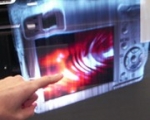
From the company's website:
Heliodisplay images are not holographic although they are free-space, employing a rear projection system in which images are captured onto a nearly invisible plane of transformed air. What the viewer sees is floating mid-air image or video. These projected images and video are two-dimensional space (i.e. planar) but appear 3D since there is no physical depth reference. While conventional displays have the benefit of being attached to a physical substrate, Heliodisplay projections are located in air, so you will notice some waviness to the quality of Heliodisplay images.
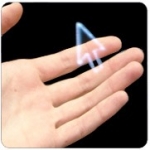
Watch the video here
19:22 Posted in Virtual worlds | Permalink | Comments (0) | Tags: Positive Technology
May 15, 2006
Powered Shoes
It has often been suggested that the best locomotion mechanism for virtual worlds would be walking, and it is well known that the sense of distance or orientation while walking is much better than while riding in a vehicle. However, the proprioceptive feedback of walking is not provided in most virtual environments. Powered Shoes is a revolutionary advance for entertainment and simulation applications, because it provides this proprioceptive feedback.
CirculaFloor is a locomotion interface using a group of movable floors. The movable floors employ a holonomic mechanism that achieves omni-directional motion. Circulation of the floors enables users to walk in arbitrary directions in a virtual environment while their positions are maintained
22:05 Posted in Virtual worlds | Permalink | Comments (0) | Tags: Positive Technology







